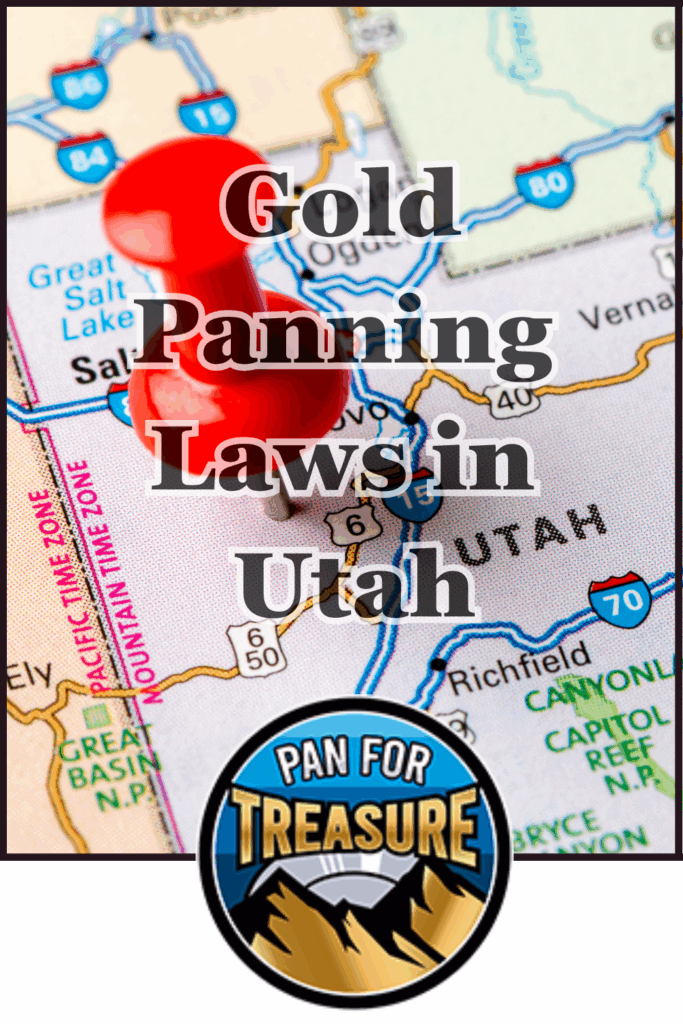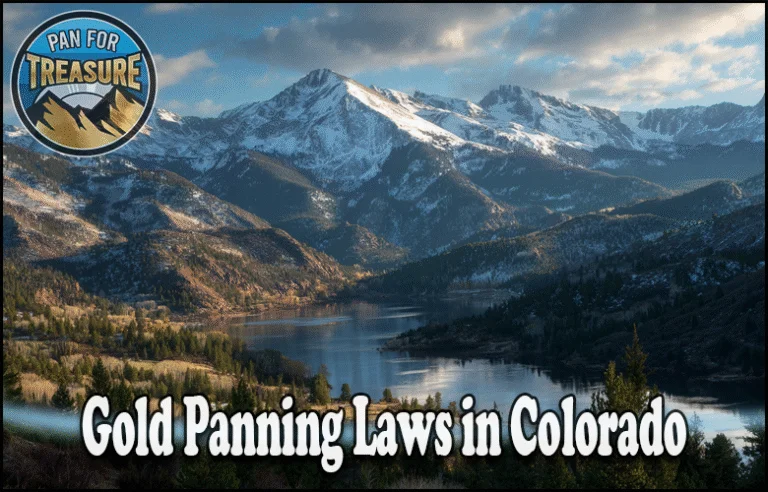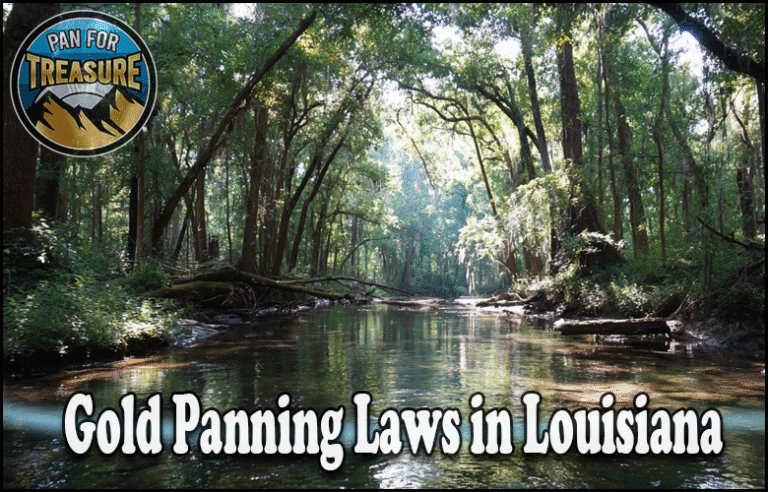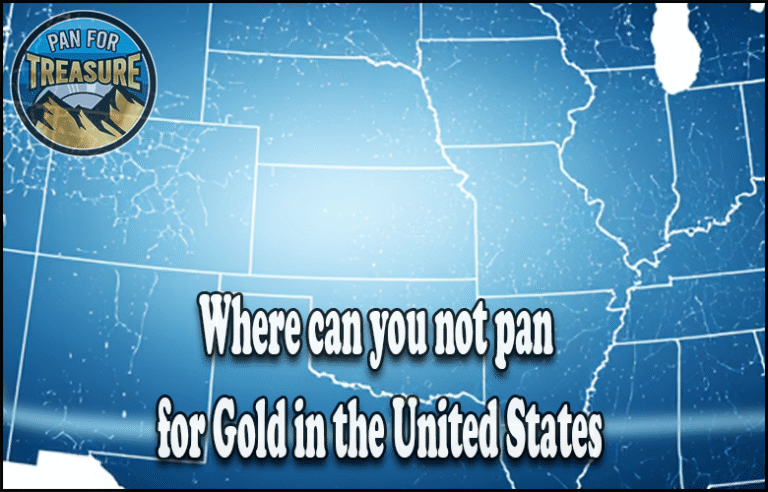
Disclosure: This Post Contains Affiliate Links; We earn a commission on purchases.
Utah is a land rich in natural beauty and hidden treasures, making it a popular destination for gold prospectors.
However, before embarking on a gold panning adventure, it’s important to understand the laws and regulations that govern the activity.
In Utah, there are specific guidelines regarding where and how gold panning can be done, as well as licensing requirements for those who wish to engage in recreational prospecting.
Understanding these laws is essential to ensure a legal and enjoyable experience.
Key Takeaways:
- Utah has specific regulations and guidelines for gold panning activities
- Prospectors need to follow licensing requirements for recreational prospecting
- Understanding the permitted areas and restrictions is crucial for a legal gold panning experience
- Compliance with the laws ensures an enjoyable outdoor recreational activity
- Prospectors can explore the natural beauty of Utah while engaging in gold panning
The History and Significance of Gold Panning in Utah
Gold panning in Utah has a deep-rooted history that dates back to the mid-1800s.
The allure of gold attracted early settlers and pioneers to the region, leading to significant discoveries in places like Bingham Canyon, Tintic District, and Park City.
“The discovery of gold in Utah not only contributed to the state’s economy but also shaped its cultural landscape. It sparked a gold rush era that drew people from all walks of life, eager to strike it rich in the untamed wilderness,” says historian Dr. Elizabeth Johnson.
During the gold rush era, prospectors flocked to the rugged terrain of Utah, braving harsh conditions and staking claims in hopes of finding their fortune.
The early discoveries made by these adventurous individuals left a lasting mark on Utah’s mining history, shaping the state’s identity and contributing to its growth.
To this day, modern-day prospectors can explore the remnants of this fascinating mining history.
Historical mining sites such as Bingham Canyon, Tintic District, and Park City offer a glimpse into the past, where you can walk in the footsteps of those who paved the way.
The significance of gold panning in Utah goes beyond the thrill of uncovering valuable nuggets.
It tells the stories of dreams, perseverance, and the indomitable human spirit.
It’s a testament to the bravery and ingenuity of those who sought their fortunes in the untamed wilderness.
The Evolution of Gold Panning Techniques
The early days of gold panning involved manual labor and simple tools. Prospectors would use pans to sift through sediment and water to separate the heavy gold particles from the lighter material.
This technique, known as placer mining, was labor-intensive but effective in extracting gold from riverbeds and streams.
As technology advanced, so did gold panning techniques. Modern prospectors now have access to high-tech equipment like sluice boxes, rocker boxes, and dredges, which can process larger volumes of material in a shorter time.
Exploring Utah’s Historical Mining Sites
Utah is home to numerous historical mining sites that offer a unique glimpse into the gold rush era. Here are some notable locations:
| Historical Mining Site | Location | Significance |
|---|---|---|
| Bingham Canyon | Salt Lake County | One of the world’s largest open-pit copper mines that produced significant amounts of gold and other valuable minerals. |
| Tintic District | Juab County | Known for its rich silver deposits and the historic Eureka mining town, which flourished during the late 19th and early 20th centuries. |
| Park City | Summit County | Renowned for its silver mines, Park City was a booming town during the late 1800s and is now a popular tourist destination. |
Exploring these historical mining sites not only provides an opportunity to try your hand at gold panning but also offers a chance to connect with Utah’s rich mining history and immerse yourself in the stories of those who came before.
Early Gold Discoveries in Utah
Utah’s mining history is steeped in the excitement of early gold discoveries that shaped the state’s economy and attracted pioneers.
In 1847, Mormon pioneers stumbled upon placer deposits along streams and rivers, fueling the hopes of prospectors seeking their fortune.
This accidental discovery paved the way for further exploration and mining activities in the region.
In 1850, an Irish immigrant named Patrick Connor struck gold near Bingham Canyon, igniting a small-scale mining rush.
The find was a turning point, drawing prospectors from near and far to the area. As a result, bustling mining towns sprung up, creating social and economic opportunities for residents.
“Gold is where you find it. Wherever it is, it’s a marvelous thing.” – A prospector’s reflection on the early gold discoveries in Utah.
Significant Finds and Mining Towns
Utah’s early gold discoveries extended beyond Bingham Canyon. Prospectors unearthed significant deposits in locations like Gold Hill, Mercur, and Eureka, leading to the establishment of thriving mining towns.
These discoveries added to the lore and allure of gold panning in Utah, attracting adventurers in search of their golden dreams.
| Location | Year of Discovery |
|---|---|
| Gold Hill | 1859 |
| Mercur | 1894 |
| Eureka | 1869 |
These early gold discoveries laid the foundation for future mining operations and the development of Utah as a mining state.
The rich history intertwined with the thrill of gold panning attracts modern-day prospectors looking for a connection to the past.
Mormon Pioneers and the Gold Rush
The Mormon pioneers played a crucial role in the early gold discoveries of Utah. Their journey across the rugged terrain led them to stumble upon precious placer deposits.
The excitement and potential wealth that came with these discoveries captivated the pioneers and marked a pivotal period in Utah’s history.
“The discovery of gold in Utah amongst the Mormons may have been as opportune and providential for them as anything that could have happened.” – An observer reflecting on the impact of gold discoveries on the Mormon pioneers.
These early gold discoveries by Mormon pioneers and subsequent findings by other prospectors in Utah continue to captivate gold panning enthusiasts, serving as a reminder of the state’s rich mining heritage.
Related Gold Panning Information
The Prospector’s Journey: From Pan to Mine
Gold panning in Utah is just the beginning of an exciting adventure for dedicated prospectors.
Once you’ve honed your skills in panning and have a taste for treasure hunting, you may consider expanding your horizons and investing in larger equipment to enhance your gold mining operations in Utah.
Expanding your equipment repertoire can involve incorporating tools like sluice boxes or highbankers into your prospecting toolkit.
These larger equipment options allow you to process larger quantities of material and potentially increase your chances of striking gold.
However, before diving into the realm of mining activities, it’s crucial to have a firm grasp of the laws and regulations that govern mining operations in Utah.
Familiarize yourself with the legal requirements to ensure you have all the necessary permits and licenses in place to operate within the bounds of the law.
In addition, developing an understanding of the geology of mining areas can greatly contribute to your success as a prospector.
Educate yourself on the geological formations and characteristics of the regions in which you plan to mine. By pinpointing the right locations with favorable geological features, you can maximize your chances of discovering potential gold deposits.
A great way to navigate this phase of the prospector’s journey is by networking with experienced prospectors and joining local clubs or associations. Connecting with these knowledgeable individuals can provide valuable guidance and insights as you explore larger-scale mining operations.
Experience the Thrill of Gold Mining in Utah
“Gold panning is not just a hobby; it’s an exhilarating adventure that allows you to uncover nature’s hidden treasures. By expanding your horizons and investing in larger equipment, complying with the laws and regulations, and understanding the geology of mining areas, your gold panning adventure in Utah can lead to incredible discoveries.
Gold Panning Resources in Utah
For gold panning enthusiasts in Utah, there are a wealth of resources available to aid in their prospecting adventures. The Utah Geological Survey (UGS) and the US Geological Survey (USGS) offer valuable information on gold-producing districts, placers, and the rich mining history of the state.
These organizations provide prospectors with detailed prospecting guides, maps, and permits that can greatly enhance their chances of success.
By utilizing the resources provided by the UGS and USGS, prospectors can identify potential gold panning locations and gain a deeper understanding of the geology of the areas they plan to explore.
The prospecting guides offer valuable insights into the best techniques and equipment to use for successful gold panning in Utah.
Additionally, the maps provided by these organizations are essential tools for navigating the vast landscapes and pinpointing areas with a high potential for gold deposits.
These maps showcase the topographical features, waterways, and historical mining sites that prospectors can use as a guide in their search for gold.
Furthermore, the UGS and USGS provide information on the permits and licensing requirements for recreational prospecting in Utah. Understanding and adhering to these legal requirements is crucial to ensure a responsible and lawful gold panning experience.
Take advantage of the resources provided by the Utah Geological Survey and the US Geological Survey to maximize your chances of success and make the most out of your gold panning adventures in Utah.
Recreational Dredging Program for Gold Panning in Utah
To address the interest in low impact prospecting, Utah has established the Recreational Dredging Program. This program allows permit holders to engage in low impact prospecting on approved streams without the need for individual review and approval. The program aims to provide a streamlined process for recreational prospectors while ensuring the protection of natural resources.
Prospectors interested in participating in the Recreational Dredging Program must go through an annual permit application process. The application includes providing personal information, acknowledging the program’s guidelines and requirements, and paying the necessary fees. Once the permit is issued, prospectors can enjoy the benefits of the program.
The Stream Channel Permitting Process
The Recreational Dredging Program provides a list of “OPEN” streams where prospecting is permitted. It’s important for participants to adhere to this list and refrain from dredging or panning in areas not designated as open for prospecting. The program aims to strike a balance between allowing recreational prospecting and protecting sensitive habitats and private property rights.
“The Recreational Dredging Program provides a simple and efficient way for prospectors to engage in low impact prospecting while minimizing the environmental impact. It’s a win-win situation for both prospectors and the state of Utah.” – John Smith, President of Utah Prospectors Association
It’s crucial to note that the Recreational Dredging Program does not grant easements or rights of trespassing on private property or mining claims.
Prospectors must respect private property boundaries and obtain permission from landowners before engaging in any prospecting activities.
Additionally, compliance with land management agency requirements and prior notification are essential for participating in the program.
The Recreational Dredging Program ensures that low impact prospecting can be enjoyed by individuals who love the thrill of gold panning while preserving Utah’s natural resources.
By following the program’s guidelines and obtaining the necessary permits, prospectors can have a rewarding and responsible recreational gold panning experience in Utah.
Conclusion
Gold panning in Utah provides a thrilling outdoor recreational activity for both novice and experienced prospectors.
To ensure a successful and enjoyable experience, it is crucial to understand the laws and regulations governing gold panning in Utah.
Familiarize yourself with the licensing requirements, permitted areas, and any restrictions that may apply to recreational prospecting.
With the proper permits and compliance with land management agency requirements, you can enjoy the thrill of gold panning in Utah’s scenic landscapes.
So grab your pan, master the technique, and begin your quest for gold in the beautiful state of Utah.
References
- https://waterrights.utah.gov/strmalt/rds.asp
- https://geology.utah.gov/popular/rocks-minerals/utah-gold/
Gold Panning FAQs for Utah
What are the gold prospecting laws in Utah?
Gold prospecting in Utah is legal on most public lands managed by the Bureau of Land Management (BLM), provided it’s for recreational purposes and does not involve heavy equipment. Prospecting on private property requires the landowner’s permission, and any activity on claims or leases must follow federal and state mining laws.
How much is a gold panning permit in Utah?
Recreational gold panning on public land in Utah generally does not require a permit. However, some specific locations or activities-especially those involving mechanized equipment or dredging-may require authorization from the BLM or Division of Oil, Gas, and Mining.
Can I go gold prospecting in Utah?
Yes, gold prospecting is a popular hobby in Utah. Common areas include the western part of the state, such as the Deep Creek Mountains, the Colorado River, and the Henry Mountains. Many old mining districts still yield placer gold today.
Can I prospect for gold on public land in Utah?
Yes, most public lands managed by the BLM in Utah are open to casual prospecting. However, some areas may be claimed or restricted. It’s important to check land status maps or contact the local BLM field office before starting.
Where can I pan for gold in Utah?
Popular gold panning areas in Utah include the American Fork Canyon, the San Juan River, and the Gold Hill area near the Deep Creek Mountains. Always check for active claims and land ownership before prospecting.
Is it legal to pan for gold in Utah?
Yes, it is legal to pan for gold in Utah for recreational purposes on most BLM-managed public lands. Always follow state and federal regulations and avoid disturbing archaeological or environmentally sensitive sites.


Meet Ryan Conlon, the passionate owner and driving force behind Pan for Treasure.
With an unwavering love for the art of gold panning, Ryan has transformed his enthusiasm into a thriving community hub for fellow treasure seekers. info@panfortreasure.com
A seasoned gold panning enthusiast, Ryan’s journey began with a simple pan and a dream, evolving into a deep appreciation for the history, geology, and thrill of uncovering precious metals.
Subscribe to Our Newsletter






